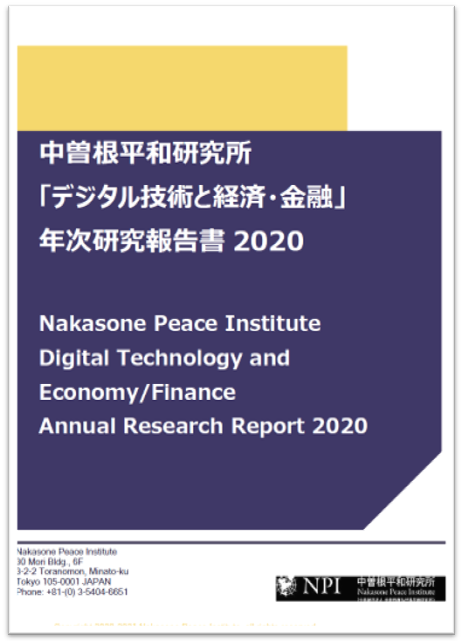2020/03/16
"Digitalized battle" against the global spread of the novel coronavirus by Yuichi Iwata (Senior Research Fellow)
"Digitalized battle" against the global spread of the novel coronavirus
Yuichi Iwata, Senior Research Fellow
■The novel coronavirus and epidemic prediction model(s)
The global expansion of the novel coronavirus (2019nCoV) continues. According to Reuters, as of March 15th, the number of patients worldwide was around 170,000 and the number of deaths exceeded 6,000. [1]
Various efforts are being made to prevent the spread using digital technology.
One of them is an epidemic prediction model. Northeastern University in the United States has developed a tool called EpiRisk (http://epirisk.net/). [2] It estimates the probability that an infected individual will spread the disease to other parts of the world through travel.
In particular, the tool can focus on how effective government interventions (transport restrictions, school closures, etc.) are on disease spread. The tool is updated on a daily basis, based on limited data availability, ever-changing situations, many assumptions complementing them, and discussion with research teams around the world.
This prediction model was created at the US Centers for Disease Control and Prevention (CDC) to help predict seasonal influenza, and various similar efforts are being made around the world. In Japan, the analysis by Professor Hiroshi Nishiura, Hokkaido University, a world leading expert in mathematical models of infectious diseases, has been contributing to the prevention of spread of infection, especially in Hokkaido. [3]
■Observing and analyzing "mutations"
It is also important to observe and analyze "mutations" that affect the infectivity of the novel coronavirus.
Viruses require a parasitic host (organism) to grow, so mutations can often occur when replicating and growing their genetic information in infected cells, especially in the case of RNA (ribonucleic acid) viruses including the novel coronavirus. [4]
By tracking the status of this particular mutation globally, a worldwide phylogenetic tree of the new coronavirus can be created, which can be used to detect locations where containment is functioning or not.
The Nextstrain project, which has already achieved such results with seasonal influenza and Ebola virus, is creating a similar phylogenetic tree for the novel coronavirus (https://nextstrain.org/ncov). [5]
■Importance of both "What is known" and "What is unknown"
Including the efforts above, when dealing with things that are difficult to grasp, the most important approach is to make the emerging problems understandable and accessible through data and surveys, which can be applied to the case of the novel coronavirus.
"Our World in Data," an online publication platform created by Dr. Max Roser of Oxford University, provides comprehensive coverage of COVID-19 caused by the novel coronavirus. (https://ourworldindata.org/coronavirus)
This platform provides, based on the disclosed data around the world, such information as the definition of the novel coronavirus, exponential growth of COVID-19, country-specific data (summarized by Johns Hopkins University, WHO, and CDC in China, etc.), and the symptoms, disease progression, and mortality risk of COVID-19.
In particular, the interpretation of mortality is carefully explained. COVID-19 is an infectious disease that is currently an epidemic, and the time from onset of symptoms to death is considered to be 2 to 8 weeks. Therefore, the mortality rate may rise or fall until the infection is under control.
Not many facts are known about the new coronavirus and COVID-19. However, it is better to know "what is known (with some reservation) and what is not known (with possible estimation)" for considering and implementing more appropriate actions.
The site above states that the most important point for addressing COVID-19 is that "Early containment allows the healthcare system to provide care for all who need it." The outbreak of severely ill patients beyond the number that the healthcare system can handle is the major risk to be avoided.[6]
By examining whether the daily changes in circumstances and measures surrounding us are also in line with the point above, we will accept the restrictions on daily activities.
*Japanese original version of the commentary, please visit: (http://www.iips.org/research/2020/03/16101127.html)
[1]According to Reuters(https://graphics.reuters.com/CHINA-HEALTH-MAP/0100B59S39E/index.html) Accessed on 16th March, 2020.
[2]Please see the IEEE site(https://spectrum.ieee.org/the-human-os/biomedical/devices/predicting-the-coronavirus-next-moves)Accessed on 11th March, 2020.
[3] Please see the Foreign Correspondents' Club of Japan site (http://www.fccj.or.jp/news-and-views/club-news-multimedia/2163-hiroshi-nishiura-combatting-the-new-coronavirus.html) and the University of Hokkaido site(https://costep.open-ed.hokudai.ac.jp/like_hokudai/contents/article/1866/ Only in Japanese)Accessed on 11th March, 2020.
[4] Please see the following article(https://www.jstage.jst.go.jp/article/jsv/55/2/55_2_221/_article/-char/en)Accessed on 11th March, 2020.
[5] Regarding the report as of 5th March, please see the following multilingual site (https://nextstrain.org/narratives/ncov/sit-rep/en/2020-03-05)Accessed on 11th March, 2020.
[6] Please see the current status of Italy lockdown...





